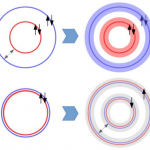Our recent joint experiment-theory paper on LaNiGa2 has just been accepted for publication in Physical Review Letters (see abstract and link to full text below). In it we present experimental data on the superconducting state of LaNiGa2 suggesting that this system has two full superconducting gaps. Interestingly, earlier work involving some of our experimental collaborators found the same behaviour (i.e. two gull gaps) in LaNiC2.

This is in spite of the different crystal symmetries (LaNiGa2 is centrosymmetric, while LaNiC2 is non-centrosymmetric) and very different predicted band structures and suggests a common pairing mechanism leading to two-gap behaviour and broken time-reversal symmetry. But earlier symmetry analyses suggest all BTRS states in these systems would have nodal gaps. How do we reconcile these observations?
Our paper addresses this question by considering two distinct scenarios for two-gap superconductors: in the conventional case (see figure, top panel) intra-band pairing between electrons with opposite spins develops in two separate Fermi surfaces, leading to two distinct gaps, one on each Fermi surface. Each gap involves pairing between electrons with opposite spin directions. This is similar to MgB2, for example, and it does not involve BTRS. In our new scenario (in the bottom panel of the same figure), pairing between electrons with the same spin direction leads to a band polarisation. The two gaps thus correspond to different spin directions rather than different Fermi surfaces. That is why we always get two values of the gap, irrespectively of how many bands we started with.
For detailed references see our paper (below).
Two-gap superconductivity in LaNiGa2 with non-unitary triplet pairing and even parity gap symmetry
The nature of the pairing states of superconducting LaNiC2 and LaNiGa2 has to date remained a puzzling question. Broken time reversal symmetry has been observed in both compounds and a group theoretical analysis implies a non-unitary triplet pairing state. However all the allowed non-unitary triplet states have nodal gap functions but most thermodynamic and NMR measurements indicate fully gapped superconductivity in LaNiC2. Here we probe the gap symmetry of LaNiGa2 by measuring the London penetration depth, specific heat and upper critical field. These measurements demonstrate two-gap nodeless superconductivity in LaNiGa2, suggesting that this is a common feature of both compounds. These results allow us to propose a novel triplet superconducting state, where the pairing occurs between electrons of the same spin, but on different orbitals. In this case the superconducting wavefunction has a triplet spin component but isotropic even parity gap symmetry, yet the overall wavefunction remains antisymmetric under particle exchange. This model leads to a nodeless two-gap superconducting state which breaks time reversal symmetry, and therefore accounts well for the seemingly contradictory experimental results.
Comments: 5 pages, 4 figures Subjects: Superconductivity (cond-mat.supr-con) Cite as: arXiv:1605.08356 [cond-mat.supr-con] (or arXiv:1605.08356v1 [cond-mat.supr-con] for this version)

